It was hot the last day on the flats. Muggy. Still. Severe clear. We were miserable as we slowly steeped in our own sweat, covered up in light, quick-dry fabric to protect ourselves from the worst of the sunshine.
And the fish seemed to feel the same way. The plentiful bones of the prior day had seemingly failed to crest the lips of the flats this day, choosing instead to stay in deeper, cooler water. As we motored around, prowling for bones and maybe, if we were lucky, a permit, we came to realize that this just wasn’t the day to be out there.
Then, as I stood on the bow of the skiff, half-heartedly gazing out over the azure Caribbean, I saw something sizable and dark moving across the blond sand flats. At first, I thought it must be one of the dozens of sting rays we’d seen cruising the shallows that day. Or maybe a small nurse shark—I’d never seen more sharks on the flats in my life than I had during the course of the week.
No. It wasn’t a ray. Nor was it a shark. As Freddie, our guide for the day, slowly poled us closer, I realized I was looking at a triggerfish. I’ve fished the flats many times, but triggers never really popped onto my radar—bonefish have always been the primary target, and if I saw triggers here or there, I never really bothered with them.
But on this day, when everything else on the flats was in hiding, this was the first of a dozen triggers we’d eventually put flies in front of. And, of all the triggers we targeted, we caught one. Those are permit numbers, honestly.
Oh, the fish were interested. And they were deliberate. Curious, even. As we dropped our little shrimp patterns in their general swimming paths, very few simply ignored the flies. Instead, they’d approach the small bonefish flies and kind of hover over them. They’d roll over slightly on their sides, as if to take a long look. We’d give the flies a little twitch, and the triggers would amiably follow, hovering again and carefully examining the potential meal.
And then Freddie would instruct us quietly from the platform.
“Strip. Stop. Let it sit.”
The fish would follow the fly, sometimes coming within just a few feet of the boat. A couple of times, a trigger followed the fly close enough to where, if one of us had managed to hook up, we only have a few inches of fly line out of the tip-top of the fly rod.
Then, as if finally noticing the skiff looming large overhead, the fish would spook and, with a powerful push with its tail and pectoral fins, it would be gone.
Then, to add insult to injury, Freddie would giggle from the platform.
“I think it actually picked your fly up three times as it followed it,” he said. “It’s very subtle.”

It also became a lesson learned. My fishing buddy for the day, a smart-mouthed fellow from Montana named Jock, hooked the first trigger of the day, realizing that as the fish seemingly hovered critically over the shrimp pattern that it was, ever so gently, mouthing the fly to determine its edibility. After a short and spirited battle, though, the fish spit the fly.
Jock hooked and fought a second trigger with the same result, teaching me lesson No. 2 of the day — when you set the hook on a trigger, you really need to set the hook.
Years before, in Ascension Bay on the southern Yucatan, our permit guides would instruct us to drive the fly home once we were fortunate enough to hook a permit. Basically, they would just tell us to pull hard on the rod and dig that hook into the fish’s mouth to avoid losing such a rare catch.
I borrowed from that lesson as I took the platform and got to put my Gotcha in front of the next trigger. It was swimming in a group of three fish — dark brown apparitions that just appeared over the otherwise lifeless flats that day. I made a solid cast and the lead fish peeled off, following the lightly-stripped fly.
As the fish hovered over the fly, I thought I noticed a slight dip in its movement, and I strip-set the bug, hooking the surprised triggerfish. Freddie laughed again from the platform.
“He’s like, ‘What is this shrimp doing biting me back?!’”
And it took a full second or two for the fish to come to grips with this new reality, that it was hooked, and that the shrimp in its mouth was, indeed, holding tight. And then all hell broke loose.
The fish, maybe a three-pounder, pumped its sizable tail and erupted on a reel-screaming run across the flats. Remembering Jock’s two hits and misses, I did my best “permit set” and drove the fly home. A few minutes later, I had my first triggerfish in hand, and an otherwise hot and miserable day on the flats had been somewhat salvaged.
We put flies in front of a few more triggers before the fishing day expired, and I realized that pursuing these odd fish was just as enjoyable as chasing bones, albeit a bit more subdued. Casting at bones is a lot about timing and fly placement. Casting to triggers is more about patience and observation. Generally, you’ll know when a bonefish picks up your fly. With a trigger, you really need to pay attention.
Triggers are common on tropical flats the world over. A member of the order Tetraordontiformes, and the Balistidae family, there are about 40 different subspecies of triggers. The biggest triggers—stone triggerfish of the tropical Pacific—can grow to about three feet long. The biggest triggers we encountered on the Bahamian flats might have been 20 to 24 inches long. Many triggers have that upward pointing ray fin along their dorsal, but not all do. They are, for good or ill, related to such tropical fare as pufferfish, boxfish and the giant ocean sunfish that’s known for basking near the surface over reefs and deep water.
Despite their decidedly “non-game” lineage, triggers are a worthy quarry on the flats, particularly when it seems as if more traditional fly-rod fare is MIA, as the bones and permit were on this day. In fact, both Jock and I declared, as we motored back to the marina, that it would be worthwhile to spend a day specifically looking for triggers and trying to solve the unique puzzles they present to the average flats angler.
On future trips to the tropics, triggers will certainly be more top-of-mind for me—the fish presented a significant challenge and required a significant mix of patience and attention in order to achieve a hookup. And, as Jock would frustratingly attest, the hookup isn’t where the chess match ends—keeping a trigger buttoned is challenging in and of itself.
So the next time things get slow on the flats, and you see what looks like a lazy, oval-shaped fish slowly working its way across the sand, make a cast. Be patient and steadfast. If you’re lucky enough, you’ll get the chance to connect with one of the most interesting fish in the sea, and, honestly, one that not everyone is going to be lucky enough to land.




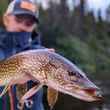


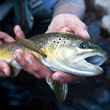







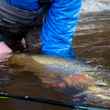
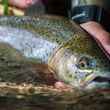









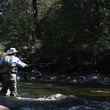

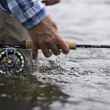

Comments
Jock replied on Permalink
“…a smart-mouthed fellow from Montana named Jock”? What is this, a limerick?
Incidentally, Doctor, heal thyself. Even your snoring is smart-mouthed.
Sincerely,
Jock
Montana
Stuart Bird replied on Permalink
Triggers are considered as one of the premier species in the Indian Ocean and ranked way higher than bonefish.
Pages